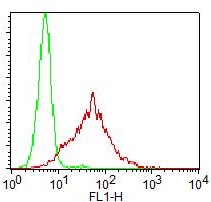Polyclonal antibody to Caspase-7 (active/cleaved)

Fig:1 Western blot analysis of Caspase-7. Recombinant catalytically active Caspase-7 was Fig:1 Western blotted with anti-Active/Cleaved Caspase-7 (20-1042). The antisera detected both the large and small subunits of active/cleaved Caspase-7.
Roll over image to zoom in
Shipping Info:
Order now and get it on Tuesday April 22, 2025
Same day delivery FREE on San Diego area orders placed by 1.00 PM
| Format : | Sera |
| Amount : | 50 µl |
| Isotype : | Rabbit IgG |
| Content : | 50 µl sera |
| Storage condition : | Store the antibody at 4°C, stable for 6 months. For long-term storage, store at -20°C. Avoid repeated freeze and thaw cycles. |
Apoptosis, or programmed cell death, is a common property of all multicellular organisms. The current dogma of apoptosis suggests that the components of the core cell-death machinery are integral to cells and widely conserved across species. Caspases, a family of cysteinyl aspartate-specific proteases, are integral components of the cell death machinery (reviewed in Siegal, 2006; and Lavrik et al, 2005). They play a central role in the initiation and execution of apoptotic cell death and in inflammation. Caspases are typically divided into 3 major groups, depending on the structure of their prodomain and their function. Group 1: inflammatory caspases (caspases 1, 4, 5, 11, 12, 14). Group II: initiator of apoptosis caspases (caspases 2, 8, 9). Group II: effector caspases (caspases 3, 6, 7). Caspases are synthesized as zymogens (inactive pro enzyme precursors which require a biochemical change to become active enzymes) with an N-terminal prodomain of variable length followed by a large subunit (p20) and a small subunit (p10). Caspases are activated through proteolytic cleavage at specific asparagine residues that are located within the prodomain, the p10, and p20 subunits. Activation results in the generation of mature active caspases that consist of the heterotetramer p202-p102. Active caspases mediate cell death and inflammation through cleavage of particular cellular substrates that are involved in these processes. The Active/Cleaved Caspase-7 polyclonal antibody antisera recognizes the large (approx. 17-22 kDa) and small (approx. 10 kDa) subunits of active/cleaved caspase-7. Whereas the antisera has a strong preference for active/cleaved caspase-7, in some cell or tissue systems or techniques the antisera may also recognize the proform of Caspase-7 (approx. 35 kDa).
WB: 1:1000-1:2000, IHC (paraffin): 1:1000-1:5000, IHC (frozen): Users should optimize, IP: 1:50-1:200
For Research Use Only. Not for use in diagnostic/therapeutics procedures.
| Subcellular location: | Cytoplasm |
| Post transnational modification: | Cleavages by granzyme B or caspase-10 generate the two active subunits. Propeptide domains can also be cleaved efficiently by caspase-3. Active heterodimers between the small subunit of caspase-7 and the large subunit of caspase-3, and vice versa, also occur. |
| Tissue Specificity: | Highly expressed in lung, skeletal muscle, liver, kidney, spleen and heart, and moderately in testis. No expression in the brain. |
| BioGrid: | 107290. 47 interactions. |
|
There are currently no product reviews
|



















.png)









